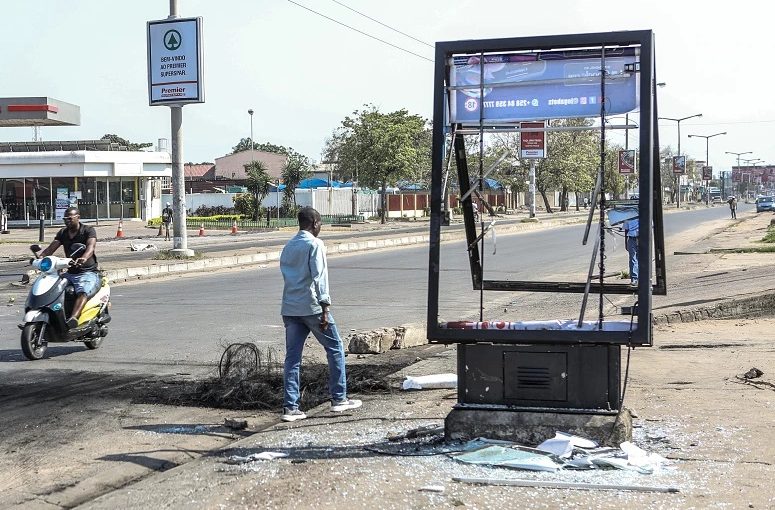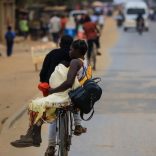Communication on focus in the Train-the-Trainers Programme - European Union Military Assistance ...
Mozambique: People trying to work among destruction from political riots

Photo: Lusa
- In Maputo, people were trying to work this morning, amidst the debris of yesterday’s clashes
Early in the morning, Ana da Conceição, 40, is selling fruit at a makeshift stall in the centre of Maputo, her pitch still shrouded in smoke. She returned after fleeing in a hurry on Thursday from the clashes between pro-Venâncio Mondlane demonstrators and the police.
“I have three children, I’m here to earn bread for my children,” she says from behind her stall on Avenida Acordos de Lusaka. But there are few customers, with Maputo practically deserted on the second day of the strike and demonstrations called by Venâncio Mondlane.
“When the war starts, we’ll evacuate. We’re trying to earn a living. Yesterday was bad, it was bad. From 4:00 p.m. onwards, they started evacuating, firing gas,” she said about the moment she had to close the stall on Thursday, when the protesters there began burning tires and street furniture and throwing stones at the police, who charged in response and threw tear gas in an attempt to disperse them.
In the morning, the little traffic in the capital was already circulating, but with drivers having to avoid stones, sticks, the remains of burnt tires and everything left over from the clashes of the previous night.
“I’m very scared,” Ana confesses. She returned to her stall this morning with one of her children, and little fruit, practically only bananas – this, so she could escape quickly if the clashes return.
She says she only has one thought: “We need this agreement, so that they [the parties] can come to an understanding. Venâncio should stay in his corner and wait for the response [about the appeals on the election results]. Because this is killing a lot of people. Hunger, war, a lot of people are dying. We want the problem to be resolved so that we can have peace.”
Somewhat apprehensive on a day of strikes and demonstrations, the third that has paralyzed Maputo this week, Gerson Antanale, a 20-year-old music producer, left his home in Mafalala to try to work amid the rubble in the streets and the lingering burning smell.
He works despite the fear, he says, because “there’s no other way”. “It would be better if they reached an agreement to end this mess we’re seeing. Because we’re in a really bad way,” he says, nervously.
During the night, in addition to the bonfires, burning tires and stones thrown everywhere, Gerson heard gunshots and saw protesters “damaging power lines”.
“It was a very difficult night,” Gerson admitted. “I’m going to try to work, but I’m scared, actually.”
For the four hours on Thursday afternoon that the National Electoral Commission (CNE) was announcing the results of the general elections of October 9, with Frelimo electing Daniel Chapo President of the Republic and strengthening its absolute majority in parliament, pro-Venâncio Mondlane protesters, who do not recognize the results, took to the streets of Maputo, burning tires and blocking avenues.
Avenida Joaquim Chissano, the site of last Friday’s double homicide of two supporters of Venâncio Mondlane, has become the main stage for clashes between protesters and police.
Protests continued throughout the night, eliciting a strong response from the police, with armoured vehicles, canine unit teams, tear gas and shots fired into the air.
Early in the morning, the trail of destruction from the last few hours was visible, as well as the remains of the burning tires that Helton Tiago, a 27-year-old refrigeration technician, was trying to get around on foot to get to work, since there is hardly any public transport.
“I feel very sad, but I also hope that things will change,” he said.
The picture of concern, he goes to work without knowing what he will be like when he returns home later. “This strike is causing negative things. I just hope that the parties come to an understanding, because it is doing harm. This strike is not doing any good,” he ventures.
“Yes, I’m going to work. Without work there’s nothing to eat,” he adds. “it was a very difficult night. I just hope there’s a dialogue between them.”
The closed shops and institutions in the city centre contrast with the activity, particularly informal, in the suburbs, but many still view the streets with apprehension.













Leave a Reply
Be the First to Comment!
You must be logged in to post a comment.
You must be logged in to post a comment.